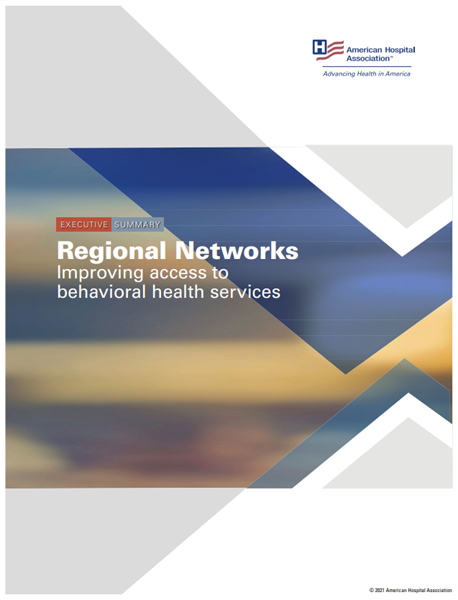Increasing access to behavioral health care services and raising awareness has taken on greater importance during the pandemic. Building and maintaining a successful regional behavioral health network through community partnerships can support this effort. Likewise, improving the social factors influencing health for those with behavioral health needs can play a vital role in making services more accessible.
A new AHA Executive Summary, “Regional Networks: Improving Access to Behavioral Health Services,” provides insights for communities that want to improve access to behavioral health services through community partnerships.
The report, based on in-depth interviews with senior health care and community leaders from five hospitals and health systems across the country, assesses key elements for building and maintaining a successful regional behavioral health network.
6 keys for building regional behavioral networks
- Engaged leadership: The hospital/health system CEO, governing body and behavioral health service-line leaders are fully committed.
- Community endorsement and support: A broad range of community leaders embrace the reality that meeting the behavioral health care needs in a community are multifaceted and must involve a coordinated initiative by hospitals/health systems, community partners, social service agencies and payers.
- Build on existing strengths and solidify funding: Assess community behavioral health needs, existing services and collaboration on improved navigation to appropriate services. Formalize funding and philanthropic efforts.
- Optimize care delivery through standard processes and handoffs: Evaluating the types of care provided in the community and region is essential. A structured access and navigation strategy with standard processes will lead to improved access to care.
- Leverage technology: Telebehavioral health services, apps and other technologies can enhance timely and appropriate access to care. An integrated electronic health record can improve provider access to improve the health of individuals.
- Actionable data and metrics: Metrics inform critical steps in improving access and evaluating outcomes. Additionally, they demonstrate value to community partners and funding sources.
The report also shares experiences and insights and key elements to success from participating organizations. For example, most network members had not previously worked in a collaborative capacity, yet ironically, each depended on one another’s services and support on a routine basis to maintain their individual efforts. That fragmented, uncoordinated care was their biggest challenge as they moved from discussion to implementation. Once they joined together with common goals, the need for continual, effective collaboration became clear.
3 ways to improve care and handoffs
- Adopt common screening and assessment tools. By standardizing and making behavioral health and social determinant screening routine in primary care, social service, crisis intervention and law enforcement interactions, patients receive improved access to the care they need. These partnership networks worked to develop integrated solutions and responses for access to crisis services or outpatient services.
- Mitigate social and medical obstacles to treatment compliance. An easily understandable behavioral health and social-screening tool can help professionals identify and navigate a system of care and services based on individualized needs and convenient availability in the home, community and specialty care settings when it works for the patient.
- Coordinate at all levels of follow-up care. Bringing medical and behavioral health care together expands access, reduces stigma and addresses the limited supply of professionals. A team-based approach to follow-up care includes natural supports (such as family, friends and religious leaders) and professionals (such as counselors, schools and probation officers). At a network level, tracking the responsiveness and access to care timelines, as well as whether a patient showed up for the initial appointment, allows the network to hold members accountable and provide outreach to patients who fail to engage in aftercare before their conditions decompensate.
Reprinted from AHA Market Scan.
Learning More
- Share your collaborations: The AHA will continue to report on community partnerships that improve behavioral health care. If your organization is working in collaboration to increase access to a continuum of behavioral health care, email behavioralhealth@aha.org.
- For more on behavioral health, consider reading Dr. Harsh Trivedi’s article “The Growing Importance of Behavioral Health in the COVID and Post-COVID Landscape” in SHSMD’s Futurescan 2022-2026 (member have access to one free digital copy).
- To listen to an in-depth conversation on this topic with Dr. Harsh Trivedi, author of behavioral health article in Futurescan 2022-2026, click here to listen to the podcast episode.